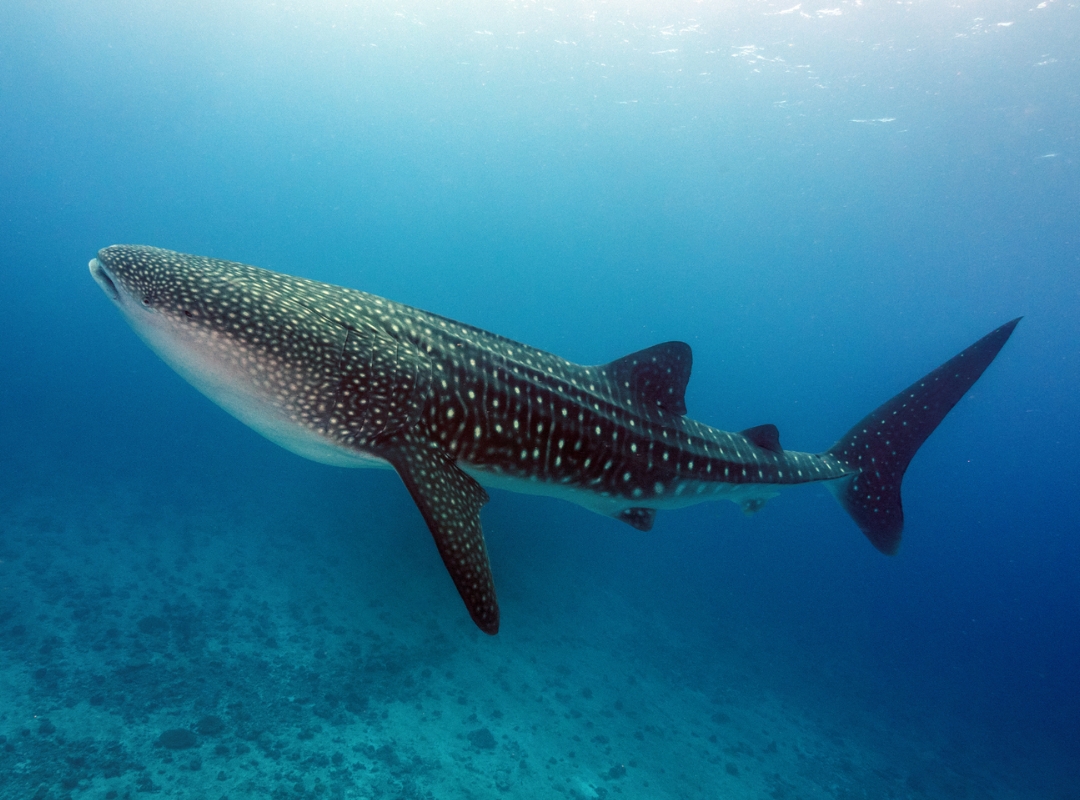Species Name
Whale Shark
Scientific Name
Rhincodon typus
Family Name
Rhincodontidae
IUCN Status
Endangered
Back and sides marked with a unique checkerboard pattern of light spots and transverse bars; head broad and flattened with short snout; mouth huge and terminal;two-lobed caudal fin is semi-lunate in adults both sides have three prominent ridges.
Biology
Length: The whale shark is the largest known fish species, with adults typically ranging from 12 to 14 meters (39 to 46 feet) in length.
Gestation period: Information on the gestation period of whale sharks is limited and difficult to determine since they are ovoviviparous, meaning the embryos develop inside eggs retained within the mother's body.
Littter size: A pregnant female has recently been found with 300 embryos, the largest of which were 58-64 cm.
Life Expectancy: It is estimated that they can live for several decades, with some individuals possibly reaching over 80 years of age.
Diet: Small fish (including sardines, anchovies, mackerel, juvenile tunas, and albacore), small crabs, and squids are some of the planktonic and nektonic food they eat. frequently observed when feeding with its head at or close to the surface and in a vertical position. When ingesting zooplankton, sharks tilt their heads side to side, with a portion of the head elevated out of the water, and their mouths open and close 7 to 28 times per minute. These suction gulps are timed with the opening and closing of the gill slits.
Habitat and Distribution
Habitat: The whale shark (Rhincodon typus) is a pelagic species found in both tropical and warm-temperate oceans around the world. These massive filter-feeding sharks are known for their migratory behavior, traveling great distances in search of food. They prefer coastal areas and the open ocean, often found in regions with high plankton concentrations, as these tiny organisms serve as their primary source of food.
Distribution: Whale sharks have a global distribution, inhabiting waters in all major oceans and seas. They are commonly found in tropical and subtropical regions, where water temperatures are generally between 21°C to 30°C (70°F to 86°F). Whale sharks are often sighted near the coasts but are also known to venture into deeper waters during their migrations.
Known landing centres: Paradip, Mumbai, Malvan, Digha Mohana, Cochin Fisheries Harbour, Vizhinjam, Kaup, Veraval, Tuticorin, Junglighat, Burma Nallah, Pudumanaikuppam, Kayalpattinam, Thoothoor, Tuticorin
Depth: Whale sharks are known to inhabit a wide depth range, but they are most commonly seen near the surface where plankton concentrations are higher. While their specific depth preferences can vary depending on factors such as feeding opportunities and seasonal migrations, they have been observed at depths ranging from the surface down to around 1,500 meters (4,900 feet).
Commercial Value
Whale sharks have the highest level of protection as a Schedule I species under the Wildlife (Protection) Act, of 1972. This makes the act of capturing and/or killing them a crime. However, they are subject to large- and small-scale bycatch in fisheries, with some national and international trade in products. All parts of the fish (the meat, fins, cartilage, skin, and viscera) are used commercially. The liver is the most important item in the commercial trade, whereas the oil from the fish is used for water-proofing boats. They are also a focal species for marine tourism industries.
Threats
Under pressure from infrastructure development, transporting and service corridors and fishing. Along the coast of Andhra Pradesh, there has been an increase in the number of whale shark strandings. The possible reason being the anthropogenic activities that have pushed the species into territories where they haven’t been documented before.There also have been evidence of microplastics from faecal samples of whale shark, indicating that the individuals might be ingesting microplastic pieces from the polluted water or indirectly through the contaminated plankton they feed on. Microplastics are known to accumulate in the individual for decades and can alter the hormones that regulate an animal’s metabolism, growth and development, and reproductive functions.
References
- Castro, A. L. F. et al (2007). Population genetic structure of Earth's largest fish, the whale shark (Rhincodon typus). Molecular Ecology 16, 5183– 5192.
- Pierce, S.J. & Norman, B. (2016) Rhincodon typus. The IUCN Red List of Threatened Species . e.T19488A2365291.
- Rowat, D., & Brooks, K. S. (2012). A review of the biology, fisheries and conservation of the whale shark Rhincodon typus. Journal of Fish Biology, 80, 1019– 1056. https://doi.org/10.1111/j.1095-8649.2012.03252.x
- Stevens, J.. (2007). Whale shark (Rhincodon typus) biology and ecology: A review of the primary literature. Fisheries Research. 84. 4-9. 10.1016/j.fishres.2006.11.008.



